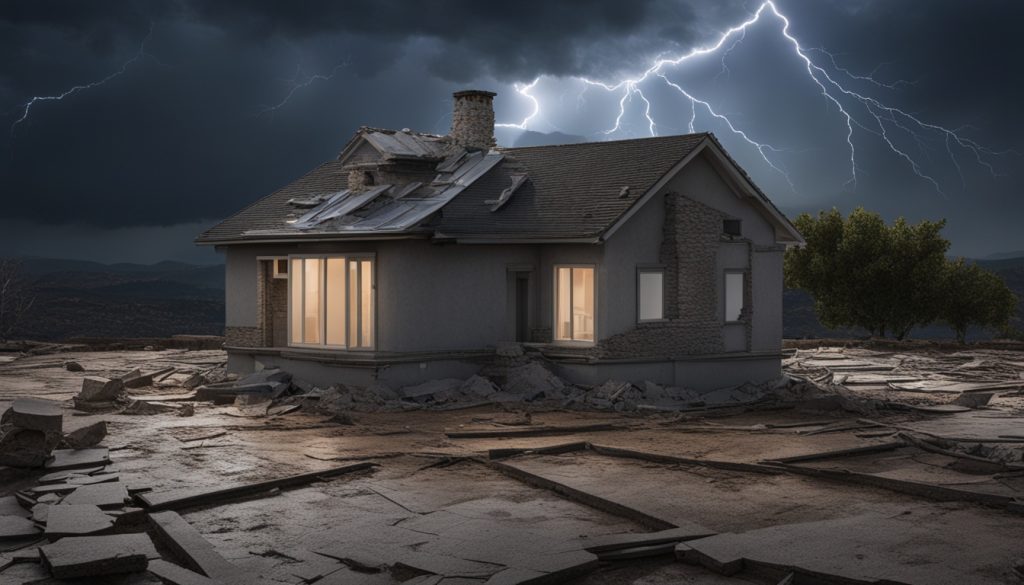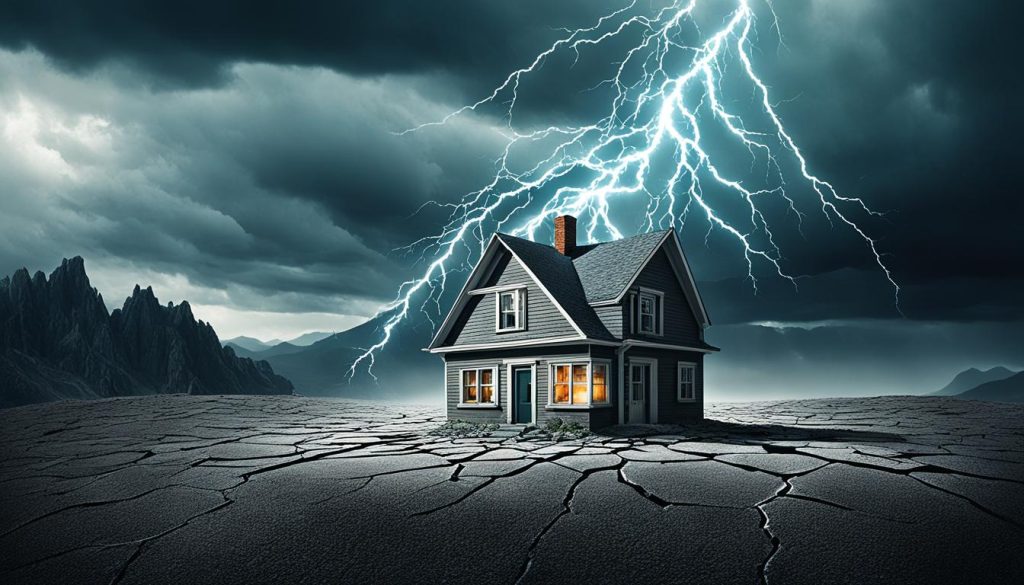Earthquakes can destroy your home, making repairs very costly. Many homeowners skip earthquake insurance because of the high costs. But, earthquake insurance is key to protect your property from earthquake damage1.
Standard homeowners or renters insurance doesn’t cover earthquake damage. Your car might be covered for earthquake damage, but not your home or belongings1. You can get earthquake coverage as a separate policy or from the California Earthquake Authority (CEA)1. This coverage helps with repairs, upgrades, and even extra living costs1.
Key Takeaways
- Earthquakes can cause significant damage to your home, often beyond the coverage of standard homeowners or renters insurance.
- Earthquake insurance provides crucial protection for your home, personal belongings, and additional living expenses in the event of an earthquake.
- Earthquake insurance policies and premiums can vary widely based on factors like location, cost to rebuild, and deductible.
- Determining your earthquake risk and considering earthquake insurance is important, even if you don’t live near an active fault line.
- The California Earthquake Authority (CEA) offers a range of earthquake insurance options to meet your specific needs and budget.
What is Earthquake Insurance?
Earthquake insurance helps protect your home and stuff if an earthquake hits. It’s not part of regular homeowners insurance2. This special coverage includes your home, personal items, other buildings on your land, and extra living costs if you have to move out while fixing your home2.
Understanding Earthquake Insurance Coverage
Earthquake insurance usually covers your home’s structure, like the foundation, walls, and roof. It also covers your personal items, like furniture and clothes. Plus, it can pay for extra living costs if your home is not safe to live in after an earthquake3.
The Importance of Earthquake Insurance
Earthquake insurance is key in places like California, Washington, and Missouri, where earthquakes are common2. Yet, many homeowners in these areas don’t have enough earthquake coverage2. Regular homeowners insurance won’t cover earthquake damage, leaving you with big repair bills and other costs4.
Having earthquake insurance means you’re prepared for a big earthquake. It helps you fix your home, replace your things, and pay for living expenses while your home is being fixed3.
“Earthquakes are a fact of life in California, but homeowners, renters, and condominium insurance policies do not cover damage from natural disasters such as earthquakes, floods, and landslides.”3
Assessing Your Earthquake Risk
To figure out if you need earthquake insurance, first, check your risk of a damaging earthquake. Look at the USGS earthquake hazard maps to see how likely seismic activity is in your area5. Your home’s location near fault lines and its age and build also play a big part in your risk5.
Earthquake Hazard Maps and Risk Assessment
The USGS has detailed maps that show where earthquakes might cause shaking and other hazards6. These maps look at things like where faults are, past earthquakes, and soil types to guess the chance of a big earthquake in your area7.
Looking at these maps helps you understand your area’s earthquake risk and how your home might be affected6. Places with high hazard ratings are more likely to get strong shaking and big damage from earthquakes7.
Also, your home’s age and build matter for earthquake risk5. Newer homes that have been made stronger might handle earthquakes better than older ones, especially those without extra support5. Wood-frame houses usually do well in earthquakes, unlike buildings made of unreinforced masonry5.

Use the info from hazard maps and check your home’s details to decide if you need earthquake insurance567.
“Earthquake insurance is key for homeowners in high-risk areas. It helps protect you financially if a big earthquake hits.”
Coverage Options for Earthquake Insurance
Protecting your home from earthquakes is crucial8. Earthquake insurance covers your home’s structure, personal belongings, other structures on your property, and living expenses if you need to move out for repairs.
Earthquake insurance covers damage from seismic events like structural damage, cracks, or collapses8. It also covers personal belongings and living expenses if your home is not safe to live in8.
Standard homeowners insurance usually doesn’t cover earthquake damage8. But, some insurers offer earthquake coverage in areas prone to earthquakes8. Homeowners insurance might cover fire damage from an earthquake8.
You can add earthquake insurance to your homeowner’s policy or buy it separately8. The California Earthquake Authority (CEA) offers earthquake insurance in California8. Make sure to read your policy to know what it covers and what it doesn’t.
| Coverage Type | Description |
|---|---|
| Dwelling Coverage | Covers the structure of your home, including the foundation, walls, and roof. |
| Personal Property Coverage | Protects your personal belongings, such as furniture, electronics, and clothing. |
| Other Structures Coverage | Covers any additional structures on your property, like detached garages or sheds. |
| Additional Living Expenses | Provides coverage for the increased costs of living, such as hotel stays and meals, if your home becomes uninhabitable due to an earthquake. |
Earthquake insurance usually covers direct damage but not secondary perils like floods or fires8. It also doesn’t cover vehicles, masonry veneers, or indirect earthquake damage8. Check your policy with your insurance provider to know what’s covered.
Homeowners can get special riders or endorsements for their earthquake insurance8. These can include coverage for masonry veneers or extra living expenses8. Check your policy to make sure you have the right protection for earthquakes8.
Determining Your Earthquake Insurance Needs
Protecting your home from an earthquake’s damage is crucial. You need to figure out the right earthquake insurance coverage. This means looking at how much it would cost to rebuild your home and what your personal belongings are worth9.
Calculating the Rebuilding Costs
Your home’s rebuilding cost should be covered by your insurance. Think about your home’s size, the materials used, and the cost of labor and materials in your area9. Where you live, your property’s value, and the type of coverage you choose can affect your earthquake insurance costs in California9.
Considering Personal Property Coverage
It’s also key to protect your personal stuff. Your coverage should match the value of your furniture, electronics, clothes, and other items. This way, you can replace them if they get damaged or destroyed in an earthquake9.
Earthquake insurance costs can change because of things like how often earthquakes happen, changes in building codes, and how providers see the risk9. Even though it’s not required in California, getting earthquake insurance is a good idea. Fixing earthquake damage can be very expensive and might be more than what you have saved9.
GeoVera’s earthquake insurance covers damage to your home, your belongings, and extra living costs if your home is not safe to live in9. Regular homeowners’ insurance usually doesn’t cover earthquake damage. So, getting earthquake insurance is a must, especially in places like California that are at high risk9.
When figuring out your earthquake insurance needs, think about how much it would cost to rebuild your home and replace your belongings. With the right coverage, you can keep your finances safe and make sure your family is ready for anything9.

Earthquake Insurance Costs and Deductibles
Earthquake insurance is key to protecting your home from earthquakes. But, the cost varies a lot based on several factors10. In Oklahoma, premiums are usually between $50 to $300 a year10. Nationally, they can go up to $800 or more11. In places like San Francisco, they can be $2,000 to $5,000 a year11.
Factors Affecting Earthquake Insurance Premiums
Your home’s size, age, and construction type affect your premiums10. So does its location and the earthquake risk there11. These factors help set your insurance costs.
Earthquake deductibles are important too. They’re usually a percentage of your home’s insured value, not a fixed amount10. This can be 5% to 25% of your coverage, giving you options to fit your budget12.
Think about what you might need to fix or rebuild your home after an earthquake11. Also, check if your policy covers earthquakes from things like oil and gas operations10.
“Earthquake insurance can be a significant investment, but it’s one that can provide invaluable protection for your home and your financial well-being in the event of a major seismic event.”
Knowing what affects earthquake insurance costs and deductibles helps homeowners make smart choices11. This insurance can give you peace of mind and protect your family’s safety and finances after a disaster101112.
Earthquake Insurance in High-Risk Areas
Homeowners in places like California pay more for earthquake insurance because of the high risk of earthquakes13. These areas often see big earthquakes that can damage homes a lot. The California Earthquake Authority (CEA) is a big help here, offering earthquake insurance to people in California.
The California Earthquake Authority (CEA)
The CEA is a not-for-profit group that gives earthquake insurance to Californians through insurance companies13. Their policies cover damage from earthquakes, helping homeowners rebuild or repair. But, they don’t cover indirect damage like fires or water damage from broken pipes, which is usually covered by regular homeowners insurance14.
For those in California, the CEA’s earthquake insurance calculator is a useful tool13. It lets you enter your home’s details to get a quote for earthquake insurance. This helps people understand how much they need to pay to protect their homes from earthquakes.
“Only 10% of California residents have earthquake insurance, despite the state’s high seismic risk13. The CEA provides a crucial safety net for homeowners who want to safeguard their most valuable asset – their home.”
Earthquake insurance is key in places like California, where earthquakes are more likely13. By learning about the CEA’s options and costs, homeowners can make smart choices to protect their homes and money if an earthquake hits.

Even though earthquake insurance costs more in high-risk areas, it’s worth it for the peace of mind and security it offers15. By understanding the challenges and solutions for homeowners in these areas, people can take steps to protect their homes and communities from earthquakes’ harm131514.
Earthquake Insurance
Protecting your home from earthquakes is vital. When looking for earthquake insurance, compare quotes from different providers to find the best policy for you16.
California is at high risk for earthquakes, with over 15,700 known faults and a high chance of a big earthquake16. Most people in California live close to an active fault, making earthquake insurance important16. Northern and Southern California face a big chance of a strong earthquake in the next 30 years16.
When comparing quotes, remember that rates change based on where your home is and the earthquake risk there. Wooden homes usually cost less to insure than brick homes because they do better in earthquakes17.
Earthquake insurance often has high deductibles, which is good for total home destruction but not for small damages17. Make sure to look at the coverage limits and deductibles of each policy. They affect the cost and how much you’re covered.
| Earthquake Insurance Coverage Comparison | Provider A | Provider B | Provider C |
|---|---|---|---|
| Coverage Limit | $300,000 | $250,000 | $400,000 |
| Deductible | 15% | 10% | 20% |
| Annual Premium | $1,200 | $900 | $1,500 |
After a big earthquake, insurance companies might stop selling earthquake insurance for a while to manage risks from aftershocks17. After the 1994 Northridge earthquake, many companies stopped offering homeowners’ insurance because of a law that requires earthquake coverage17.
By comparing earthquake insurance quotes and understanding what they cover, you can find the right policy for your home and assets. Earthquake insurance is key to protecting your investment, especially in California’s earthquake-prone areas16.

Mitigating Earthquake Risks for Homeowners
As a homeowner, you can take steps to lower your earthquake risks and maybe even get lower insurance rates. One key step is seismic retrofitting. This makes your home stronger against shaking and movement from earthquakes18. Studies show that retrofitting can cut your earthquake insurance costs by 10% to 25% in California18.
There are more ways to get your home ready for an earthquake. Disaster preparedness steps, like securing furniture and having an emergency kit, make your home safer and easier to recover from a quake18. These actions boost your family’s safety and might lower your insurance costs18.
Seismic Retrofitting and Disaster Preparedness
Seismic retrofitting means making your home’s foundation, walls, and roof stronger against earthquakes. This can include adding steel bracing and securing the home to its foundation18. These changes can greatly reduce the chance of damage and make your home more stable during an earthquake18.
Being prepared for disasters is also key. This means securing heavy furniture and having an emergency kit ready18. With these steps, you can make your home and family safer during a big earthquake18.
Earthquake Risk Mitigation, Seismic Retrofitting, and Disaster Preparedness are vital for protecting your home and loved ones from earthquakes18. By doing these things, you can protect your property and might get discounts on your Earthquake Safety insurance18.
“Preparedness is the key to surviving and thriving in the aftermath of an earthquake. Investing in seismic retrofitting and disaster readiness can make all the difference in protecting your home and family.”
| Earthquake Risks | Mitigation Strategies | Potential Benefits |
|---|---|---|
| Structural Damage | Seismic Retrofitting | 10-25% Discount on Earthquake Insurance18 |
| Furniture and Appliance Damage | Securing Heavy Objects | Improved Home Resilience and Safety18 |
| Disruption to Essential Services | Emergency Preparedness | Faster Recovery and Less Displacement18 |
By taking steps to reduce earthquake risks, homeowners can protect their homes and might get lower earthquake insurance rates18. With a strong approach to Earthquake Risk Mitigation, Seismic Retrofitting, and Disaster Preparedness, your home and family will be safer from earthquakes18.
Conclusion
Earthquake insurance is key for homeowners in high-risk areas19. It helps protect your home and money if an earthquake hits. Knowing what coverage you need and getting the right policy is important19. Even though it costs money, the benefits can be huge if your home gets badly damaged20.
Doing things to make your home safer, like seismic retrofitting, can lower your insurance costs20. With the right insurance and safety steps, you can feel secure. Your home will be ready for an earthquake, one of the worst natural disasters1920.
Earthquake insurance is vital for homeowners. It helps you recover faster after an earthquake19. By getting ready for earthquakes and choosing the right insurance, you keep your home and family safe. This way, your most important asset stays safe for a long time1920.
FAQ
What is earthquake insurance?
Earthquake insurance is a type of coverage that protects your home and property from earthquake damage. It covers your dwelling, personal items, other structures on your land, and living expenses if you need to move out while fixing your home.
Why is earthquake insurance important?
Earthquake insurance is key because it helps pay for repairs after an earthquake. Standard homeowners insurance doesn’t cover earthquake damage. Earthquakes can severely damage or even destroy buildings.
How do I know if I need earthquake insurance?
Check if you need earthquake insurance by looking at earthquake hazard maps from the USGS. See if your area is at risk. Your home’s location, age, and construction also play a part in your risk level.
What does earthquake insurance cover?
Earthquake insurance usually covers your home, belongings, other structures, and living expenses if you can’t stay in your home. You can also get riders for specific items like masonry veneers.
How much earthquake insurance coverage do I need?
To figure out how much coverage you need, think about rebuilding your home and replacing your belongings. Make sure your dwelling coverage covers rebuilding costs. Your personal property coverage should match your belongings’ value. Don’t forget to consider living expenses if your home is damaged.
How much does earthquake insurance cost?
Earthquake insurance can be pricey, with costs between 0 and ,000 a year. Your location, home’s age and build, number of stories, and rebuilding costs affect the price. Deductibles are usually 10% to 20% of your coverage.
How can I find the best earthquake insurance policy?
Look for the best policy by comparing quotes from different companies. Each company has its own way of setting rates. Bundling your earthquake insurance with homeowners can also save you money.
What can I do to mitigate my earthquake risks?
Lower your earthquake risks by making your home stronger. Seismic retrofitting can cut your insurance costs by 10% to 25% in California. Also, prepare for disasters by securing furniture and having an emergency kit to make your home more resilient.
Source Links
- Earthquake insurance for homeowners | III
- Earthquake Insurance
- Earthquake Insurance
- Earthquake Insurance | Missouri Department of Insurance, Financial Institutions and Professional Registration
- Assess Your Earthquake Risk – Do I Need Earthquake Insurance?
- Background on: Earthquake insurance and risk
- How do I decide whether or not to get earthquake insurance?
- What Is Earthquake Insurance and Do You Need It?
- The Most Affordable Earthquake Insurance – Quake Insurance
- Earthquakes – Oklahoma Insurance Department
- Earthquake Insurance | American Family Insurance
- Earthquake insurance: Do you need it?
- Insurance Topics | Earthquake Insurance
- What Is Earthquake Insurance? | Bankrate
- Earthquake Insurance: Do You Need It?
- California Earthquake Authority
- Earthquake insurance
- Mitigating and Preparing for Earthquakes
- Earthquake Insurance: Closing the Insurance Gap
- Earthquake Insurance: What You Need to Know – NerdWallet

